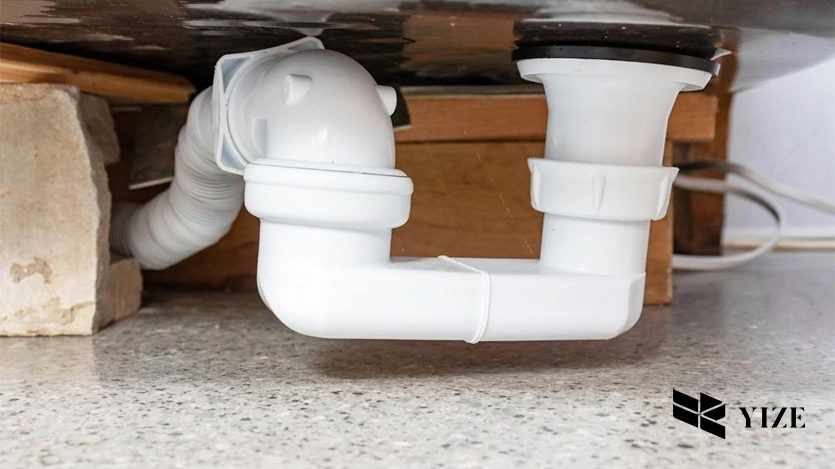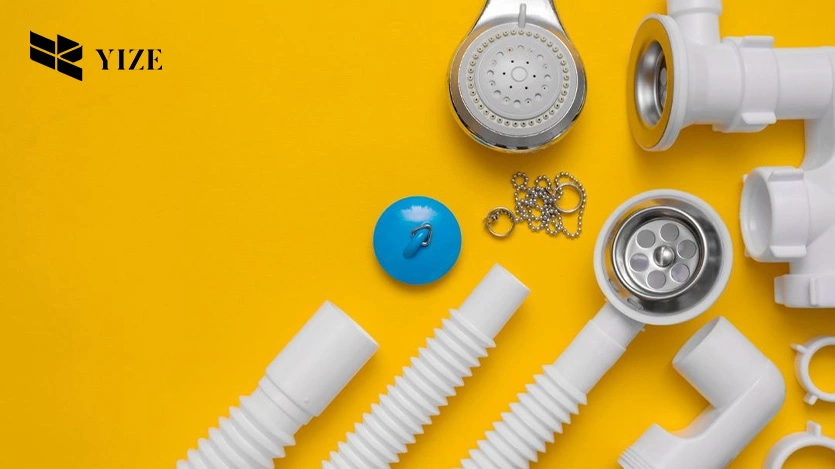
That faint, funky smell creeping from your shower drain isn’t just annoying. It could be sewer gas. Many don’t realize the simple plumbing part standing guard against it: the shower drain trap. Ignoring it? That’s an open door for bad odors and even pests. Nearly all plumbing codes mandate traps for this very reason.
Here’s what we’ll cover: “Does a shower drain need a trap?”:
- What a shower drain p-trap does for your shower.
- The stinky, unwelcome results of not having one.
- Why building codes absolutely require them.
- How these simple curved pipes actually work.
Getting the trap right is fundamental. Pairing it with a well-built drain assembly matters too.YIZEDrain designs stainless steel shower drains meeting tough international standards like WATERMARK and CUPC, ensuring the whole system offers reliable performance for years.
I. What a P-trap Does for Your Shower

You’ve probably seen that U-shaped pipe under your kitchen or bathroom sink. Your shower has one too, usually hidden beneath the floor. This simple piece of plumbing is called a P-trap (or sometimes just a trap).
Its main job is straightforward but absolutely necessary. The P-trap for shower drain blocks unpleasant sewer gases from wafting up through your shower drain and into your home.
How does it work? That signature curve in the pipe holds a small amount of water all the time. This water creates a seal, a liquid barrier. It effectively plugs the pipe, stopping gases from the sewer line from passing through, while still letting your shower water drain away easily. Each time you shower, you replenish this vital water seal.
Without this constant water barrier, your drain pipe would be an open pathway directly to the main sewer line. Not exactly the fresh scent you want while getting clean.
II. The Stinky, Unwelcome Results of Not Having One
So, what actually happens if that P-trap is missing or fails? First and foremost: the smell. You provide a direct, open path for sewer gases to flow right into your living space. These aren’t just unpleasant; they contain gases like methane and hydrogen sulfide. Not something you want to breathe regularly.
Beyond the stench, an open drain pipe is like rolling out the welcome mat for pests. Drain flies, cockroaches, and other critters that thrive in sewer systems can easily crawl up the pipe. Suddenly, you might find yourself with some very unwelcome, unhygienic roommates using your shower drain as an entrance.
That simple curve filled with water is the only thing preventing this smelly, creepy-crawly situation. It’s a basic but critical barrier for a clean and healthy home environment.
III. Why Building Codes Absolutely Require Them

There’s a good reason P-traps aren’t just a suggestion – they are required by virtually all plumbing codes (like theUniform Plumbing Code orInternational Plumbing Code). Skipping a trap isn’t just cutting corners; it violates basic building standards across the board. Why the strict rule?
The primary driver is public health and safety. Those sewer gases we mentioned aren’t just foul-smelling; exposure can be unpleasant or even harmful over time. Codes exist to protect occupants from these gases and the potentially harmful bacteria present in the sewer system. It’s a fundamental sanitation measure.
Building codes set the minimum standard for safe, habitable structures. Ensuring every drain has a functional trap is part of that baseline. Reputable drain manufacturers design products, likeYIZEDrain’s certified stainless steel models (meeting WATERMARK and CUPC standards), specifically to integrate seamlessly with these code-compliant trap systems for safe, long-term performance.
IV. How These Simple Curved Pipes Actually Work
The way a hair trap for a shower drain works is clever yet simple, much like keeping water in the bottom of a U-shaped tube. It boils down to a few key steps:
- Gravity Holds Water: The distinct U-shape uses basic gravity to permanently hold a small amount of water in the lowest part of the curve.
- The Water Seal: This trapped water acts as a physical barrier, like a liquid plug, constantly sealing the pipe.
- Blocking the Path: It specifically blocks the opening leading back towards the sewer line, stopping gases from passing through.
- Flow and Replenish: When you shower, the incoming wastewater simply pushes the old water out of the trap and continues down the drain. As the flow stops, the trap automatically refills with fresh water.
- Easy Drainage: Importantly, this water seal doesn’t stop your shower water. It flows easily over the barrier and down the drain line.
This elegant system relies on steady water flow to function correctly. That’s why well-designed drains, like thevarious certified options from YIZEDrain (including horizontal, vertical, or 360° rotatable outlets), help ensure water moves efficiently into the trap to maintain that protective seal.
V. Ready to Keep Things Flowing Fresh with YIZEDrain?
So, does a shower drain need a trap? Absolutely YES. This simple U-shaped pipe plays a huge role in keeping your bathroom pleasant and hygienic by blocking sewer gases and pests. It’s not just a recommendation; it’s fundamental plumbing.
Here’s a quick recap on the best shower drain hair trap:
- P-traps create a water seal to block sewer gases and critters.
- Plumbing codes mandate them for basic health and safety.
- Missing traps directly lead to unpleasant smells and potential pest entry.
- They work using a simple curve that holds water via gravity.
A working low-profile shower drain trap performs best when connected to a quality drain assembly.YIZEDrain provides certified stainless steel drains (meeting standards like WATERMARK and CUPC) designed for reliable, long-term performance. Choosing a well-made drain ensures your entire shower system functions smoothly, keeping that vital trap seal effective.
P Trap Shower Drain FAQs
Q1: Can you install a shower without a trap?
No, you really shouldn’t, and in most places, you legally can’t. Installing a shower without a P-trap violates plumbing codes. It creates an open path for potentially harmful sewer gases and pests to enter your home, posing health risks.
Q2: Should shower drains have a trap?
Yes, absolutely. Every modern shower drain requires a P-trap connected to it. Its primary function is to hold water, creating that crucial seal that blocks odors and critters from coming up the drainpipe. It’s fundamental for basic sanitation.
Q3: Does a shower need a water trap?
Yes. A “water trap” is just another common name for the P-trap (or S-trap in some older plumbing) used in drains. Your shower definitely needs this device, which relies on holding water to prevent sewer gases from entering your bathroom.
Q4: Do I need a hair trap in my shower drain?
This refers to something different from the essential P-trap. A hair trap, or drain strainer/screen, sits visibly in the drain opening to catch hair and soap scum before they go down the pipe. While not usually required by code, using one is highly recommended. It helps prevent clogs further down, ensuring your P-trap and drain line function properly.
